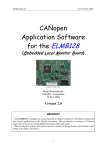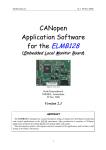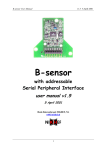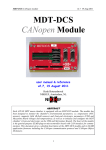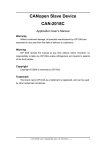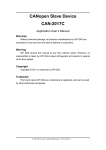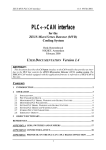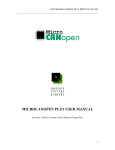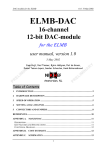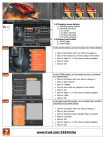Download CANopen B-sensor readout system user manual, version 0.4
Transcript
BsCAN CANopen module v0.4 29-May-2001 BsCAN CANopen B-sensor readout system user manual, version 0.4 29 May 2001 Henk Boterenbrood ([email protected]) 1 BsCAN CANopen module v0.4 29-May-2001 Table of Contents 1 INTRODUCTION.............................................................................................................. 2 2 OPERATION...................................................................................................................... 4 2.1 2.2 2.3 INITIALISATION............................................................................................................... 4 CONFIGURATION............................................................................................................. 5 READ-OUT ...................................................................................................................... 6 3 BSCAN OBJECT DICTIONARY .................................................................................... 8 4 EMERGENCY OBJECTS .............................................................................................. 13 REFERENCES........................................................................................................................ 14 1 Introduction The BsCAN CANopen application is a custom-made solution for reading out multiple 'addressable B-sensor modules' (described in [1]), using the CAN-bus and the CANopen protocol ([2]) for communication with a host system. BsCAN is implemented on a CRYSTAL-CAN-V2 box (which has been slightly modified for this application), a general-purpose microcontroller module with CAN-interface and eight SPI (Serial Peripheral Interface) connectors for linking up to external I/O. The CRYSTAL-CAN-V2 module is built around a 16-MHz Philips 80C592 8-bit microcontroller with on-chip CAN controller. It provides 48 kByte of user program memory and 63.5 kByte of user RAM [1]. Program code (in standard Intel Hex format) can be downloaded directly via the RS232 port (which is accessible only after opening the box). The BsCAN box can have up to 8 strings of B-sensor modules connected to its SPI connectors. A string is one (10-wire flat-)cable with one or more B-sensor modules. A special adapter module is needed between the B-sensor cable and the CRYSTAL-CAN's SPIconnector. It provides the proper connector conversion and signal buffering. The number of B-sensor modules connected to one string and to one BsCAN box is only limited by electrical conditions and in practice means that up to about 10 B-sensor modules can be connected to one string, and a total of up to 30 to 40 B-sensor modules can be connected to one BsCAN box. A string can have a length of up to about 15 meter (preliminary information; tested and working is a cable of 10 meters with 10 B-sensor modules). See Figure 1 for an example of a BsCAN system configuration. A requirement is that the B-sensor modules connected to one BsCAN box must have a unique address. The address of a B-sensor is printed on a sticker on the board and is a number that lies between 0 and 127. This address is stored on-board in non-volatile memory (for details see [1]). 2 BsCAN CANopen module v0.4 29-May-2001 adapter to next CAN-node adapter adapter CRYSTAL-CAN-V2 CAN-bus to host system Figure 1. Schematic picture of a BsCAN system consisting of 3 strings and a number of Bsensor modules. A B-sensor module can be added to the system onto any string and a string can be connected to any of the 8 CRYSTAL-CAN-V2 SPI connectors. However, after adding B-sensors or strings to a BsCAN box (or moving a B-sensor module from one string to another) it is necessary to initiate a configure operation on the BsCAN box. During this operation the BsCAN box will determine automatically where and which B-sensor modules are connected to it, subsequently store the new configuration in its onboard non-volatile memory and finally reset and calibrate all B-sensor modules (for details see [1]). At every subsequent power-up or reset the system assumes this configuration is the current configuration (and repeat the reset and calibrate operation on the B-sensor modules). The user will be informed about any B-sensor modules missing (or not functioning) or having changed string position. Added B-sensors are ignored and are not read out until after the next configure operation. As seen from a controlling host system, B-sensor modules are accessed on the basis of their unique address and CAN-node module-id only, their location on a string is irrelevant. All information about a BsCAN's current configuration can be read from a number of entries in its Object Dictionary (see section 3). 3 BsCAN CANopen module v0.4 29-May-2001 2 Operation 2.1 Initialisation Important: • When powering up the system it should be switched off and immediately after switched on again: due to a hardware bug in the B-sensor microcontroller (Atmel AT90LS2343) the program in the microcontroller does not start up at the first power-up: it needs to be powered off and on for the on-chip RC oscillator to start running ! After power-up, watchdog reset, manual reset or CANopen initiated reset actions a CANopen node sends a so-called Bootup message (a Network ManagemenT (NMT) message defined in the CANopen standard) as soon as it has finished initialising (which takes a couple of seconds); this is a CAN-message with the following syntax: BsCAN (NMT-Slave) → Host (NMT-Master) COB-ID 0x700 + NodeID Byte 0 0 The COB-ID is the Communication Object Identifier, the 11-bit CAN-message identifier defining one unit of transportation in a CAN network. The NodeID is the CAN node identifier set by means of the CRYSTAL-CAN-V2 switches (accessible on the frontpanel), which must be in the range between 1 and 127. To simplify matters, after power-up or reset the BsCAN node automatically goes into Operational state, and the host application can immediately start reading out the B-sensor modules, by sending CANopen SYNC messages (see section 2.3 for details). Note that the CANopen standard defines that after power-up/reset a node goes into Preoperational state. Before any input channels can be read using the PDO mechanism, the connected CANopen-nodes have to be set into the Operational state. If for any reason the BsCAN node has been set into another state (see [2]) other than Operational, it can be set into the Operational state using the 2-databyte NMT message shown below. There is no reply from the node to this CAN-message. Host (NMT-Master) → BsCAN (NMT-Slave) COB-ID 0x000 Byte 0 1 (Start_Remote_Node) Byte 1 Node-ID or 0 (all nodes on the bus) 4 BsCAN CANopen module 2.2 v0.4 29-May-2001 Configuration To trigger the BsCAN node to probe its strings for B-sensor modules and store the newly found configuration to non-volatile memory, a CANopen SDO (Service Data Object) message must be send to read Object 5000h, subindex 0 (see the Object Dictionary in section 3). All Bsensors found are subsequently reset and calibrated. The reply message sent has one significant databyte, containing the total number of B-sensor modules found. Here is a description of these CAN-messages, the SDO-client (request from host) and SDOserver (reply from BsCAN) CAN-message: → BsCAN Byte COB-ID 0 0x600+ 0x40 NodeID Host 1 0x00 2 0x50 3 0x00 4 – 5 – 6-7 – Assuming everything went well and the number of B-sensor modules found is 30 (2Dh), BsCAN replies with the following message: BsCAN → Host Byte COB-ID 0 0x580+ 0x4F NodeID 1 0x00 2 0x50 3 0x00 4 0x2D 5 – 6-7 – A full probing operation (scanning 8 strings, each for addresses 0 to 127) takes approximately 10 seconds to complete, also depending on the number of modules found. If for any reason an SDO-client request from the host fails BsCAN replies with a so-called SDO Abort Transfer message; this message has the following syntax: → Host Byte COB-ID 0 1 0x580+ 0x80 index NodeID (LSB) BsCAN 2 index (MSB) 3 subindex 4-7 Abort Code See Table 1 below for a description of some Abort Codes (see also [2]). 5 BsCAN CANopen module Abort Code 0503 0000 0504 0000 0601 0000 0602 0000 0606 0000 0609 0011 0800 0000 v0.4 29-May-2001 Description Toggle bit not alternated SDO protocol timed out Unsupported access to an object Object does not exist in the Object Dictionary Object access failed due to a hardware error Sub-index does not exist General error Table 1. SDO Abort Domain Transfer: descriptions of some Abort Codes (in byte 4-7). 2.3 Read-out To trigger the read-out of all connected B-modules (their 3 Hall-sensors and 1 T-sensor) a socalled SYNC message must be send. The SYNC message is a CAN-message with a fixed COB-ID and no data bytes: Host → all (SYNC-)slave nodes COB-ID 0x080 After receiving this message the BsCAN node starts up a sequence of AD-conversions on all B-sensor modules simultaneously to convert the H1, H2 and H3 Hall-sensors and the Tsensor, and subsequently reads out the converted analog inputs and sends them one-by-one in a message on the CAN-bus. Strings are scanned for data from BsCAN string connector 0 to connector 7, and B-sensor modules on one string are scanned from the lowest to the highest B-sensor module address. Per B-sensor module the messages arrive in the order H1, H2, H3 and T respectively. In practice this means that after a conversion sequence is started (a SYNC message is received by the BsCAN node) it takes about 4*80=320 ms for the conversion sequence to complete and the first message arrives (for an AD-conversion wordrate of 15 Hz). The 4 messages from one B-sensor module are about 1.5 ms apart. The time between the last message of one B-sensor module and the first message of the next B-sensor module is about 5 ms. For example: read-out of 32 B-sensor modules on 4 strings by one BsCAN box takes about 4*80 + 4*5 + 32*1.5 ms, which is roughly about 0.4 seconds from start to finish… The message containing an ADC value is called a TPDO (Transmit Process Data Object) in CANopen jargon, which is a message without any further CANopen protocol overhead. The data bytes in the message contain application data only. 6 BsCAN CANopen module v0.4 29-May-2001 BsCAN will produce –per channel– the following 6-databyte TPDO message containing the data for one ADC channel conversion: BsCAN → Host TPDO COB-ID Byte 0 0x280+NodeID Address with: Address: Chan no: ADC value: ADC-config: BIT Meaning Byte 1 Chan no Byte 2 ADC-config Byte 3-5 ADC value B-sensor module address (between 0 and 127). 0 = Hall H1, 1 = Hall H2, 2 = Hall H3, 3 = T-sensor. 24-bits value, LSB in byte 3, MSB in byte 5. bit 7: not used. bits 6-0: ADC configuration: conversion word rate (bits W0, W1 and W2), gain range (bits G0, G1 and G2) and unipolar or bipolar (bit U/B); see below. For definitions see OD index 3000h-307Fh, sub 2,3,4,5,6 and 7. 7 - 6 W2 5 W1 4 W0 3 G2 2 G1 1 G0 0 U/B (NB: BsCAN supports other modes of readout for this PDO (e.g. timer-triggered), but this is not further described in detail here). Example messages with ADC data: BsCAN → Host TPDO COB-ID Byte 0 Byte 1 Byte 2 Byte 3 Byte 4 Byte 5 0x290 0x13 0x02 0x00 0xB0 0xD6 0xFF This is a message from BsCAN node 16 (NodeID=0x290-0x280=0x10, see COB-ID): • B-sensor 19 (=0x13, Byte 0) • Hall-sensor H2 (channel number 2, Byte 1) • Gain range = 100 mV bipolar, conversion word rate = 15.0 Hz (Byte 2) • 24-bit ADC-value -10576 (=0xFFD6B0, Byte 3+4+5) Note: a Hall-sensor conversion value is a 24-bit signed number ! (note the negative value above) BsCAN → Host TPDO COB-ID Byte 0 Byte 1 Byte 2 Byte 3 Byte 4 Byte 5 0x290 0x13 0x03 0x0B 0x26 0x6B 0x98 This is a message from BsCAN node 16 (NodeID=0x290-0x280=0x10, see COB-ID): • B-sensor 19 (=0x13, Byte 0) • T-sensor (channel number 3, Byte 1) • Gain range = 2.5 V unipolar, conversion word rate = 15.0 Hz (Byte 2) • 24-bit ADC-value 624306 (=0x986B26, Byte 3+4+5) Note: a T-sensor conversion value is a 24-bit unsigned number ! 7 BsCAN CANopen module v0.4 29-May-2001 3 BsCAN Object Dictionary The values of objects marked with ∗ in the Index column can be saved in EEPROM for permanent storage in non-volatile memory. They are retrieved from EEPROM at reset and power-up (The B-sensor mapping, Object 4300, is automatically stored). Communication Profile Area (BsCAN) Index (hex) Sub Index Name Data/ Object Attr 1000 - Device type U32 RO 00040191h 1001 1002 - Error register Manufacturer status reg U8 U32 RO RO 0 0 1008 1009 100A - Manufacturer device name Manufacturer hw version Manufacturer software version VisStr VisStr VisStr RO RO RO "CRYS" "CRY2" "BC10" 100C 100D * - Guard time [ms] Life time factor U16 U8 RO RW 1000 0 Store parameters Highest index supported Save all parameters Save communication parameters Save application par's Array U8 U32 U32 RO RW RW 3 1 1 U32 RW 1 Restore default parameters Array 0 1 Highest index supported Restore all parameters U8 U32 RO RW 3 1 2 Restore communication parameters Restore application par's U32 RW 1 U32 RW 1 Producer Heartbeat Time [1 ms] U16 RO 0 Identity Number of entries Vendor ID Record 1..4 U32 RO RO 1 12345678h 1010 0 1 2 3 1011 3 1017 * - 1018 0 1 1 Default Comment Meaning: DSP-401 device profile, analogue inputs on device 1 (see footnote) = CRYSTAL-CAN = CRYSTAL-CAN-V2 BsCAN application v1.0 = 1 second 0 → no lifeguarding timeout Save stuff in onboard EEPROM Read: 1; Write "save": store all Read: 1; Write "save": store PDO par's, Life time factor, … Read: 1; Write "save": store ADC config, … Invalidate stuff in onboard EEPROM; use defaults Read: 1; Write "load": invalidate all parameters stored Read: 1; Write "load": invalidate stored PDO par's, etc. Read: 1; Write "load": invalidate stored ADC config, etc. Truncated to multiples of 1000; = 30 s, if Heartbeat enabled Mandatory CANopen object Manufacturer Status Register: status for B-sensor modules #0 to #31; 1 bit per module: 0=OKAY, 1=Error/Absent. 8 to be ordered from CiA BsCAN CANopen module v0.4 29-May-2001 Communication Profile Area (BsCAN) (continued…) Index (hex) Sub Index Name Data/ Object Attr Default 0 1 2nd Transmit PDO par's Number of entries COB-ID used by PDO Record U8 U32 RO RO Transmission type Inhibit time [100 µs] Event timer [1 ms] U8 U16 U16 RW RO RW 5 280h + NodeID 1 0 0 2 3 5 0 2nd Transmit PDO mapping Number of entries Record U8 RO 3 1 2 B-sensor/ADC address B-sensor channel number U32 U32 RO RO 40000008 30000108 3 24-bit analogue input U32 RO 40xx0y18 1801 * * 1A01 Comment Data type = PDOCommPar 9 According to CANopen Predefined Connection Set Only 1 and 255 allowed not used Truncated to multiples of 1000; active if transm-type = 255 Data type = PDOMapping should be 255 for MuxPDO, but this is not a CANopen MPDO… actually not allowed, but… OD-index 3000, sub-index 1: size = 8 bits OD-index 40xx, sub-index y: Analogue inputs, multiplexed, size = 24 bits BsCAN CANopen module v0.4 29-May-2001 Manufacturer-specific Profile Area (BsCAN) Index (hex) Sub Index Name Data/ Object Attr Default 8 9 10 11 12 13 14 15 16 17 18 B-sensor #0 ADC-config Number of entries Number of input channels Conversion Word Rate Hall-sensors Input Voltage Range Hall Unipolar/Bipolar Measurement Mode Hall Conversion Word Rate Temperature sensor Input Voltage Range Temp Unipolar/Bipolar Measurement Mode Temp Power Save Mode Configuration Register Offset Register #1 Gain Register #1 Offset Register #2 Gain Register #2 Offset Register #3 Gain Register #3 Offset Register #4 Gain Register #4 Channel-Setup Register #1 Record U8 U8 U8 RO RO RW 21 7 0 U8 U8 RW RW 0 0 U8 RW 0 U8 U8 RW RW 0 0 Bool U32 U32 U32 U32 U32 U32 U32 U32 U32 U32 WO RW RW RW RW RW RW RW RW RW RW 19 Channel-Setup Register #2 U32 RW 20 Channel-Setup Register #3 U32 RW 21 Channel-Setup Register #4 U32 RW B-sensor #1 ADC-config Record … … B-sensor #2 ADC-config Record etc … … … … … … … … B-sensor #127 ADC-config Record … … … NB: some settings are global for all B-sensor modules ! … 3000 * 0 1 2 * * 3 4 * 5 * * 6 7 3001 etc 3002 … 307F etc Comment CRYSTAL CS5524 24-bit ADC … (Global setting!) 3-bit code 2 (Global setting!) 0 = bipolar, 1 = unipolar (Global setting!) 3-bit code 1 (Global setting!) 3-bit code 2 (Global setting!) 0 = bipolar, 1 = unipolar (Global setting!) 1 = power save CS5523 Config Register CS5523 physical channel AIN1 CS5523 physical channel AIN1 CS5523 physical channel AIN2 CS5523 physical channel AIN2 CS5523 physical channel AIN3 CS5523 physical channel AIN3 CS5523 physical channel AIN4 CS5523 physical channel AIN4 LC 1 (12-bits) in lower 2 bytes, LC 2 (12-bits) in upper 2 bytes LC 3 (12-bits) in lower 2 bytes, LC 4 (12-bits) in upper 2 bytes LC 5 (12-bits) in lower 2 bytes, LC 6 (12-bits) in upper 2 bytes LC 7 (12-bits) in lower 2 bytes, LC 8 (12-bits) in upper 2 bytes … NB: some settings are global for all B-sensor modules ! … … NB: some settings are global for all B-sensor modules ! … … 1 000: 15.0 Hz, 100: 101.1 Hz, 001: 30.0 Hz, 101: 1.88Hz, 010: 61.6 Hz, 110: 3.76 Hz, 011: 84.5 Hz, 111: 7.51 Hz 2 000: 100 mV, 001: 55 mV, 010: 25 mV, 011: 1 V, 10 3-bit code 1 100: 5 V, 101: 2.5 V BsCAN CANopen module v0.4 29-May-2001 Manufacturer-specific Profile Area (BsCAN) Index (hex) Sub Index Name Data/ Object B-sensor module status Record Number of entries status B-sensors #0-#31 status B-sensors #31-#63 status B-sensors #63-#95 status B-sensors #96-#127 U8 U32 U32 U32 U32 RO RO RO RO RO 3200 ADC-reset-and-calibrate B-sensor #0 U8 WO 3201 ADC-reset-and-calibrate B-sensor #1 ADC-reset-and-calibrate B-sensor #2 … … ADC-reset-and-calibrate B-sensor #127 ADC-reset-and-calibrate all B-sensors in config U8 WO Writing any value triggers a reset and calibration sequence on Bsensor #0 with its current ADC settings reset+calib of B-sensor #1 ADC U8 WO reset+calib of B-sensor #2 ADC … … U8 … … WO … … reset+calib of B-sensor #127 ADC U8 WO 3100 0 1 2 3 4 3202 … … 327F … … 3280 4000 0 1 2 3 4 5 6 7 0 1 … 7 Read analogue input B-sensor #1 Number of entries Input 1 … Input 7 U8 I24 … I24 RO RO … RO … … … … … … … … Record 0 1 … 7 Read analogue input B-sensor #127 Number of entries Input 1 … Input 7 407F Default 4 0xfffffff 0xfffffff 0xfffffff 0xfffffff Record U8 I24 I24 I24 I24 I24 I24 I24 24 bits analogue value (B-sensor address #0) RO RO RO RO RO RO RO RO 7 Record U8 I24 … I24 Comment Error status, one bit per B-sensor 0=OKAY, 1=Error or Absent Read analogue input B-sensor #0 Number of entries Input 1: Hall-sensor H1 Input 2: Hall-sensor H2 Input 3: Hall-sensor H3 Input 4: current sense Input 5: NTC T-sensor Input 6: 0ºC calib input Input 7: 100ºC calib input 4001 … … Attr 1st analog input:24-bit 2nd " " " 3rd " " " 4th " " " 5th " " " 6th " " " 7th " " " 24 bits analogue value (B-sensor #1) 7 1st analog input:24-bit … 7th " " " … … 24 bits analogue value (B-sensor #127) RO RO … RO 11 7 1st analog input:24-bit … 7th " " " BsCAN CANopen module v0.4 29-May-2001 Manufacturer-specific Profile Area (BsCAN) Index (hex) Sub Index 4100 Name Data/ Object Attr 0 B-sensor address list Total number of B-sensors U8 RO 1 … n Address of 1st B-sensor … Address of n th B-sensor U8 … U8 RO … RO Number of B-sensors per string Total number of strings Number of B-sensors on string #0 Number of B-sensors on string #1 Number of B-sensors on string #2 Number of B-sensors on string #3 Number of B-sensors on string #4 Number of B-sensors on string #5 Number of B-sensors on string #6 Number of B-sensors on string #7 Array 4200 0 1 2 3 4 5 6 7 8 U8 U8 RO RO U8 RO U8 RO U8 RO U8 RO U8 RO U8 RO U8 RO 4300 * 0 B-sensor-to-string mapping string# with B-sensor #0 Array U8 RO * * * * 1 2 … 127 string# with B-sensor #1 string# with B-sensor #2 … string# with B-sensor #127 U8 U8 … U8 RO RO … RO 5000 - Probe strings for B-sensors RO 12 Default Comment = number of modules found when probing (see Object 5000) … 8 value 0xFF means: this B-sensor not found in any of the strings " " … " stores newly found mapping (Object 4300) in EEPROM; resets and calibrates all B-sensors found; returns Object 4100, sub 0; takes about 10 s to complete. BsCAN CANopen module v0.4 29-May-2001 4 Emergency Objects Emergency messages are triggered by the occurrence of an internal (fatal) error situation. An emergency CAN-message has the following general syntax: BsCAN → Host COB-ID Byte 0-1 080h + Emergency Error Code NodeID Byte 2 Error Register (Object 0x1001) Byte 3-7 Manufacturer specific error field The following Emergency messages can be generated by the BsCAN application: Error Description Emergency Error Code Error Register bit (Object 1001H) Manufacturer-specific Error Field (byte 3-7) (byte 0-1) (byte 2) CAN communication 8100 10 Byte 3: 81C91 Interrupt Register content Byte 4: 81C91 Mode/Status Register content Byte 5: error counter Life Guarding 8130 10 (CAN-controller has been reinitialized) EEPROM: write failed 5000 80 EEPROM: read error 5000 80 Byte 3: 41 Byte 4: Parameter block index 1 Byte 5: 0 : writing block info > 0: size of parameter block to write Byte 3: 42 Byte 4: Parameter block index 2 Byte 5: Error id (1=CRC, 2=length, 4=infoblock) B-sensor ADC: conversion timeout B-sensor ADC: reset failed 5000 80 5000 80 B-sensor ADC: offset calibration failed B-sensor ADC: gain calibration failed B-sensor ADC problem(s) during initialisation 5000 80 5000 80 Byte 3: 54 Byte 4: B-sensor address (0..127) 5000 80 Byte 3: 55 Byte 3: 51 Byte 4: B-sensor address (0..127) Byte 5: ADC channel number (0..3) Byte 3: 52 Byte 4: B-sensor address (0..127) Byte 5: Error id 3 Byte 3: 53 Byte 4: B-sensor address (0..127) Note that the Error Register (Object Dictionary index 0x1001) can have one or more of the bits shown above set, depending on the node's history of errors since the last reset. The table shows the Error Register bit that gets additionally set when the corresponding error occurs. 1 2 3 0: PDO communication parameters, 1: Guarding parameters, 2: ADC configuration, 3: Bsensor-to-string mapping idem 01: Reset-Valid bit not set, 02: Reset-Valid bit not reset, 04: error in Offset Register value, 08: error in Gain Register value 13 BsCAN CANopen module v0.4 29-May-2001 References [1] H.Boterenbrood, B-sensor with addressable Serial Peripheral Interface, Version 1.3, NIKHEF, Amsterdam, 27 March 2001. (http://www.nikhef.nl/pub/departments/ct/po/html/Bsensor/Bsensor.pdf [2] H.Boterenbrood, CANopen, high-level protocol for CAN-bus, Version 3.0, NIKHEF, Amsterdam, 20 March 2000. (http://www.nikhef.nl/pub/departments/ct/po/doc/CANopen30.pdf). [3] CRYSTAL CS5521/22/23/24/28, 16-Bit or 24-bit, 2/4/8-Channel ADCs with PGIA, CIRRUS LOGIC product datasheet, DS317F2, May 2000, (http://www.cirrus.com). 14














